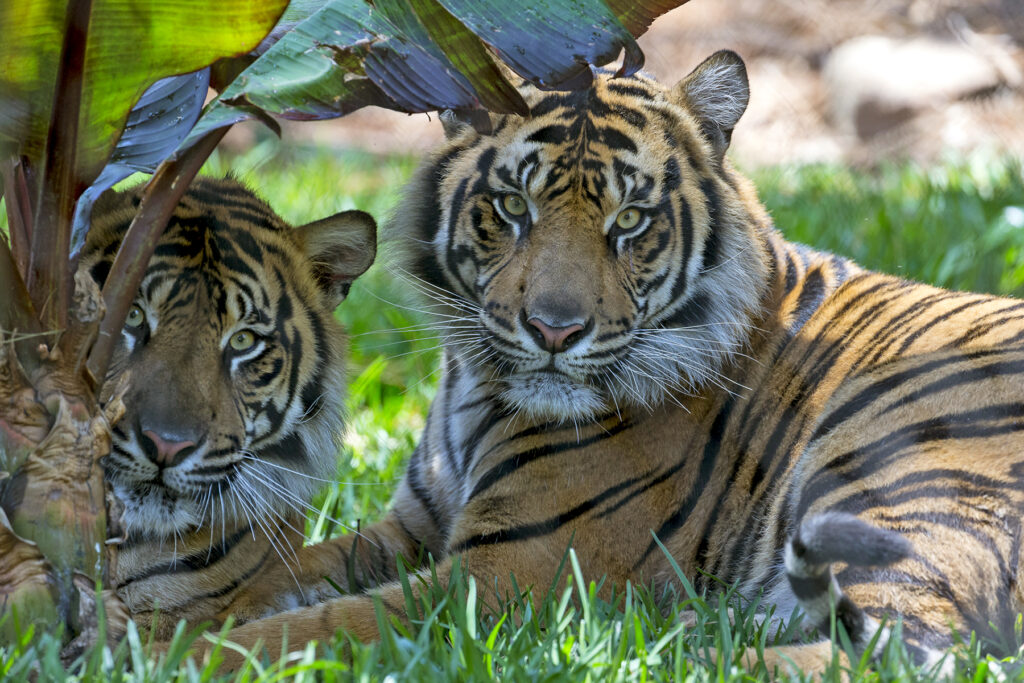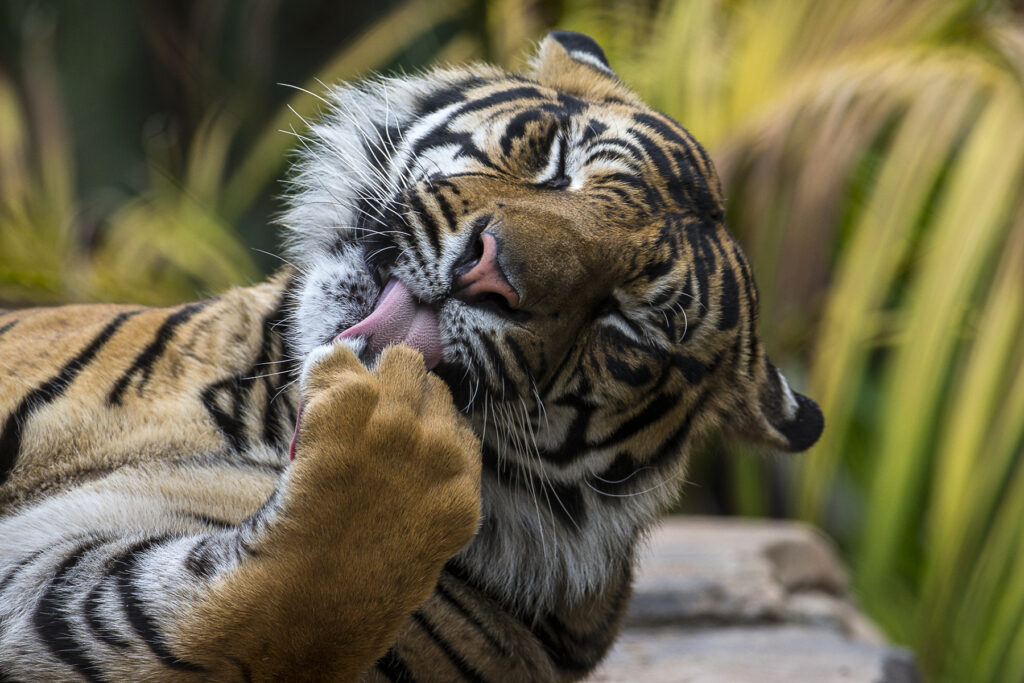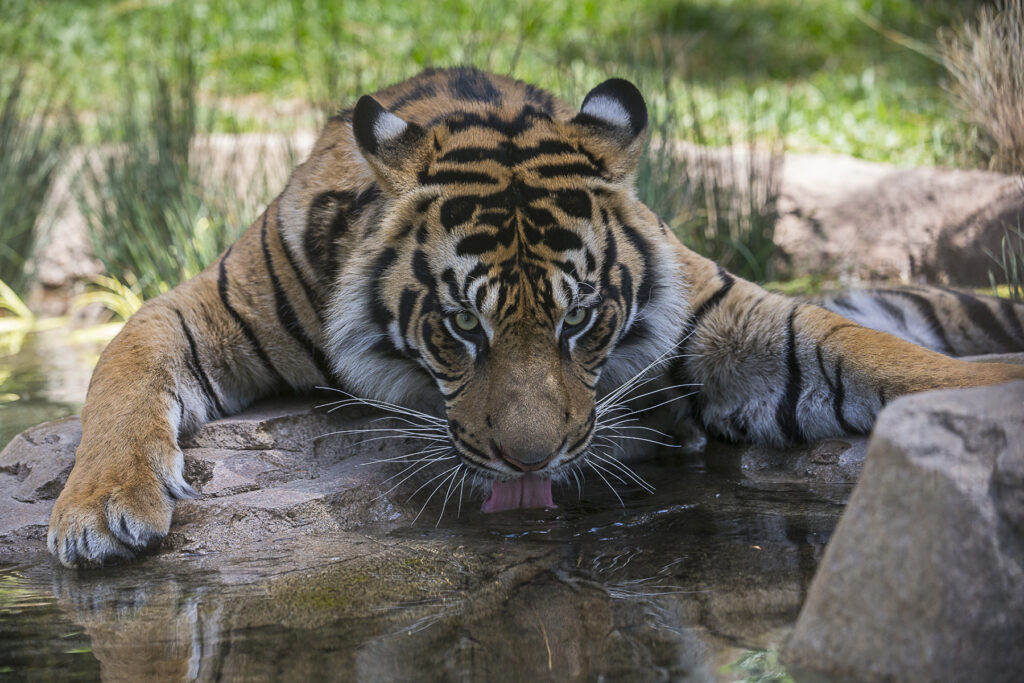San Diego Zoo Global is uniquely positioned to conserve threatened wildlife both in situ and ex situ. Wildlife at the Zoo and the Safari Park can provide critical clues to the behavior and ecology of their wild counterparts via noninvasive data collection. In honor of Global Tiger Day, July 29, we would like to share how the Sumatran tigers at the Safari Park are helping their wild counterparts in Sumatra.
“It is an exciting time here supporting our important field work, as we are able to collect fecal and blood samples to produce data to assess genetic variation,” explained Justine Zafran, senior wildlife care specialist at the Safari Park, who has worked with the tigers for over six years. These efforts will help lay the groundwork for a cutting-edge project to find an accurate and practical way to count wild tigers in Sumatra. “It might be surprising that we still do not have a counting strategy all scientists and assessors can agree on,” said Mrinalini Erkenswick Watsa, Ph.D., Bud Heller Fellow, San Diego Zoo Global. As part of the Population Sustainability and Conservation Genetics teams, she and her colleagues are employing a combination of motion-detecting cameras as well as revolutionary approaches like genome sequencing technologies to detect individual tigers in Sumatra.

All living things are constantly shedding their DNA into the environment. Tigers slough off traces of their DNA in footprints as they walk, seasonally shed fur, scat deposited regularly, pungent scent marks used to mark their territories, and even on prey they eat and water they drink. Of course, the elements—wind, sun, and rain—quickly degrade these samples. “But if we collect environmental samples soon after deposition, and isolate tiger DNA from them, I believe we can use this information to create a database of wild Sumatran tiger DNA profiles,” Mrinalini said. This would shed light on not only how many tigers there are, but how closely related the population may be. One way that researchers can collect DNA is through “hair snares” where a piece of sticky, scented (many tigers enjoy Obsession by Calvin Klein!) material that attracts tigers to rub on it, leaving hairs behind that can be analyzed and documented in the field. Researchers are looking at ways of modifying this efficient, low-cost mechanism so that the snare closes after a tiger deposit, ensuring the sample is from a single cat.
Before the pandemic, wildlife specialists at the Safari Park, who work with the tigers daily, were able to collect DNA samples non-invasively, and Mrinalini was able to begin fine tuning genomic testing on the Safari Park cats and improve design on data collection sheets. The next phase was to “transfer that knowledge to a practical field application on the island of Sumatra.” But COVID-19 restricted travel to Sumatra, as well as access to the laboratory and even to tigers at the Park. “The project had to adapt to this unique situation,” Mrinalini said. While unable to travel to Sumatra, she will still be able to work directly with the field teams at Sintas Indonesia Foundation, our partner institution in Sumatra, to establish a virtual training session on sample collection, so once their shutdowns are lifted, they will be able to utilize new protocols to conduct field sampling. In April, in an abundance of caution, sample collection was put on hold at the Safari Park.

Wildlife care specialists continued to work, of course, taking great care of the striped felines. Justine explained that with five females and one male, all closely related, things can get testy among them. “We are always cogniscent of the social dynamic of different cats,” said Justine. “Fortunately, we have ‘buffer rooms’ available, and we can also use Rakan, the male, to keep the peace.” Rakan came to the Park from another zoo as a cub, as his mother was unable to nurse him after developing an infection. Meanwhile, a tiny tiger cub had been confiscated at the US-Mexico border and was placed in care of the Safari Park. Close in age, the two “boys” were raised together, and later Moka went to another sanctuary, while Rakan remained at the Safari Park. As part of the Species Survival Program, two of the females at the Park were going to go to other zoos, but the pandemic put a stop to all animal transfers. Fortunately, the tiger habitats have plenty of greenery, private areas, pools, and waterfalls to provide optimal living. In June, new additional biosafety protocols were put in place to keep the cats and staff collecting samples safe, so the tiger genome project can resume.

The last island-wide estimate of Sumatran tiger numbers was conducted 10 years ago, so this conservation genomics project is more urgent than ever, and will add important data to the fore. It will reveal how many tigers there are, how stable the populations are, and the genetic diversity (or lack thereof) of these mighty hunters. These science-based answers will help guide the future for wildlife and humans on this beautiful island and beyond.
Karyl Carmignani is a staff writer for San Diego Zoo Global. Read Tiger, Tiger (Part 1).





